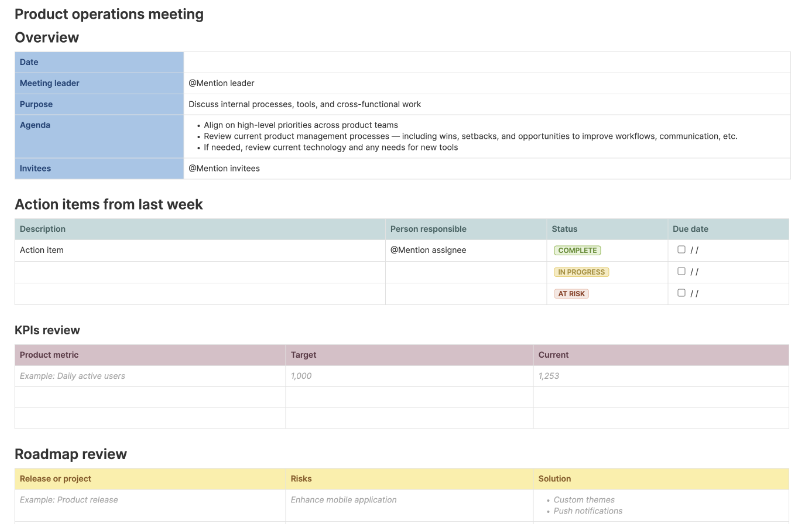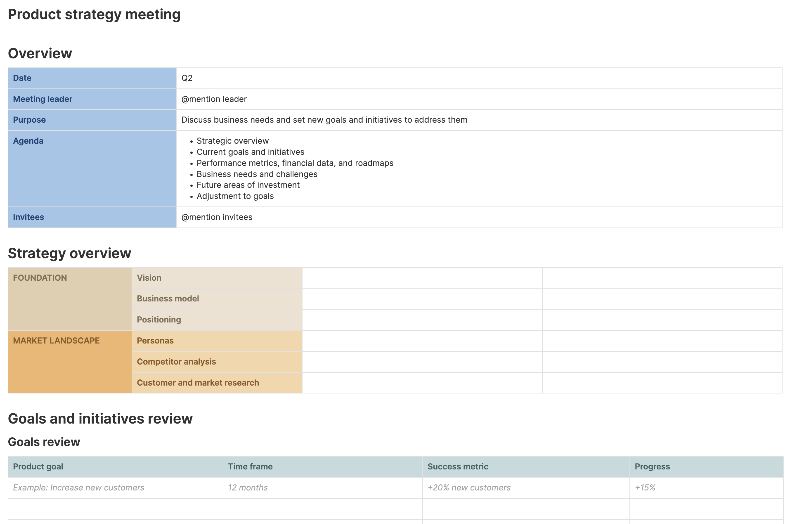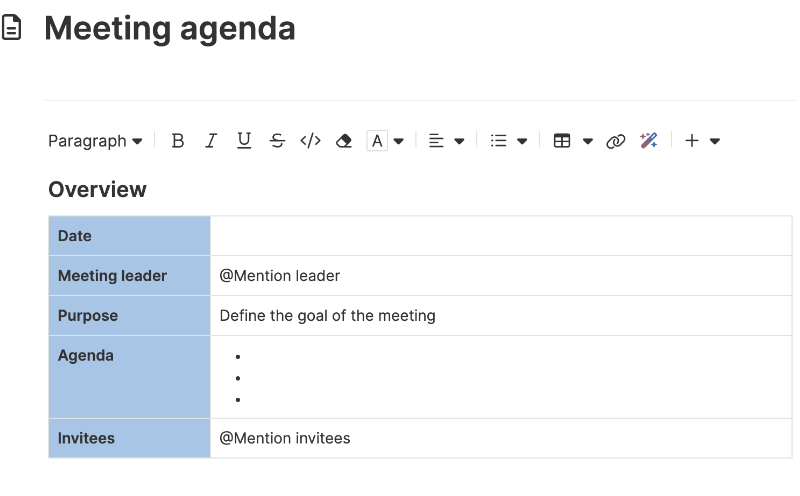Product feature kickoff meeting template
Coordinate the team before building something new
Use template
About the product kickoff meeting template
Kicking off a new feature is a routine part of product development — but it still deserves thoughtful preparation. These meetings give teammates a shared understanding of what they will build, why it matters, and how to get started. Use this template to lead a clear, focused conversation and document what you need to move ahead. You can outline goals, clarify scope, raise open questions, and define immediate next steps. A simple, well-run kickoff helps prevent confusion later on.
Included in the product feature kickoff meeting template
This product feature kickoff meeting template includes built-in capabilities such as:
A structure to help you capture and organize your thoughts
Quick access to best practices for running your meeting
A rich text editor to format content clearly
Inline comments to gather feedback, questions, and ideas from teammates
An AI assistant to help you draft and summarize meeting notes
How to use the product feature kickoff meeting template
Use this template when you have a prioritized and resourced feature or user story that the team is ready to build. It is best suited for aligning on the feature's purpose and the early steps needed to move it forward — before diving into design or development.
Start by adding a short summary of the feature and linking relevant strategy documentation, research, or customer feedback. You can build an agenda that covers goals, scope, and open questions from there. Invite your cross-functional team and use inline comments to capture reactions in real time. Afterward, assign follow-ups and share the document so everyone stays aligned.
Best practices
Set a strong foundation for your next product feature.
Start with the why: Clarify the problem this feature is meant to solve and how it fits into broader business or customer goals. Share relevant context from prior research or planning.
Describe the intended experience: Outline what you want users to be able to do and what success looks like. This may include early concepts, UX goals, or draft user flows — the things you need to get aligned without locking into solutions too soon.
Talk through constraints and considerations: Raise technical, legal, design, or data-related issues that might shape your approach. Get ahead of blockers and surface any assumptions that need testing.
Define what needs to happen next: List follow-ups, such as customer interviews, whiteboard sessions, architecture reviews — whatever you need to move from idea to plan. Assign owners and timelines where possible.
FAQs about the product feature kickoff meeting template
Why is a kickoff meeting important for product features?
The kickoff meeting sets the tone for everything that follows. A good kickoff saves time later by clarifying intent upfront — not just what the feature is, but what trade-offs have already been made, which areas still need input, and how the team will collaborate. It also helps uncover differing assumptions before they become blockers.
What should a product feature kickoff cover?
It should cover more than just goals and scope. Bring in relevant insights (like strategic context, customer feedback, or usage data) to ground the conversation. Address what is known, what is uncertain, and what decisions still need to be made. This gives the team enough clarity to move forward without locking into details prematurely.
Who should attend?
Start with the core team responsible for designing and building the feature: usually product management, engineering, and design. Consider also including customer-facing teammates, like support or success, if they bring useful context or will need to communicate the change to users. Avoid overloading the meeting; keep it small enough to be productive.
Is this template free to use?
Yes. To use this product feature kickoff meeting template, sign up for a free 30-day trial of Aha! Whiteboards. (You can also try this template in Aha! Roadmaps if you need a complete product management solution.) Easily customize the template to suit your needs, then share it with as many people as you want (for free) to streamline collaboration.





